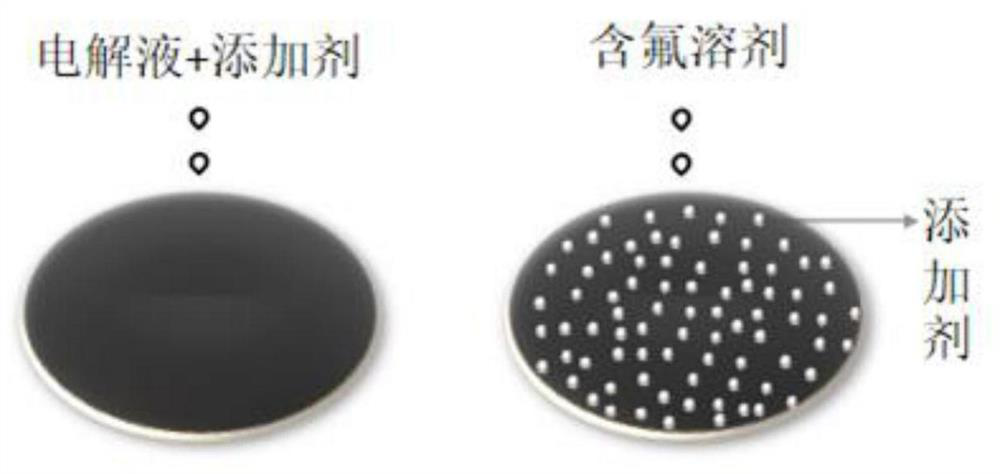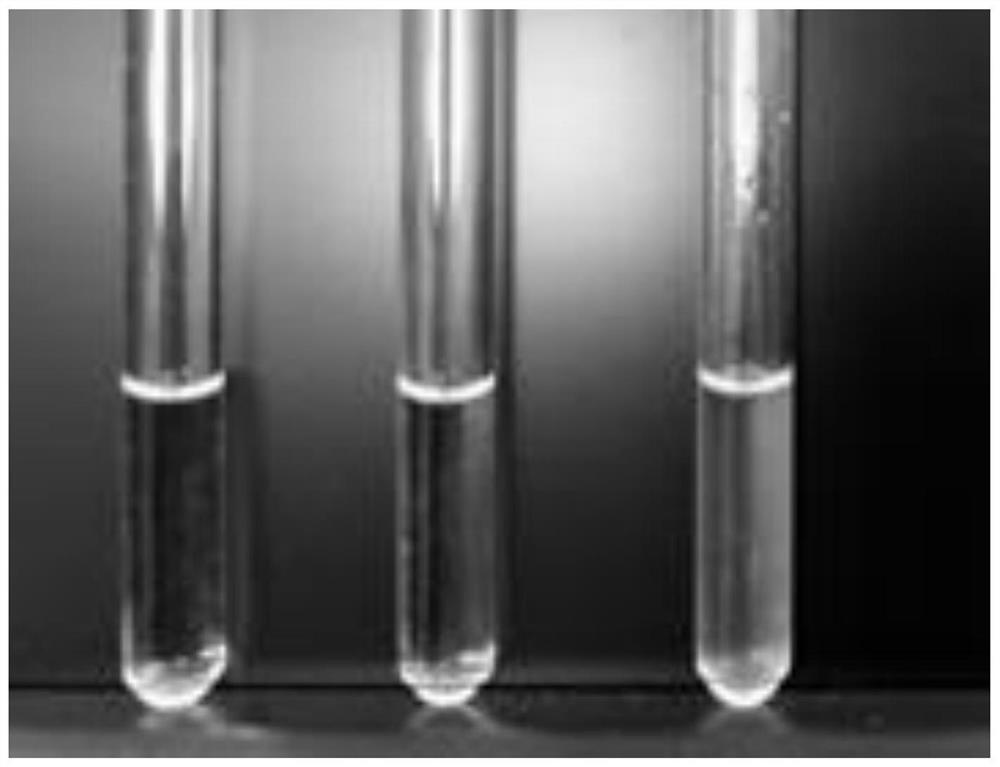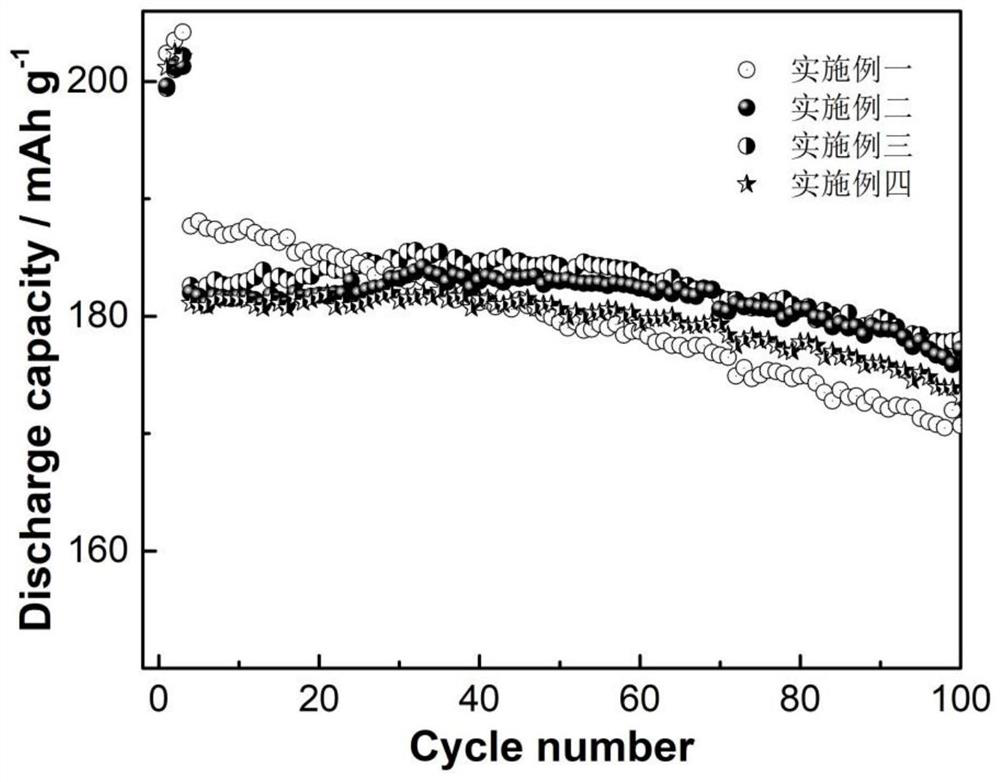A kind of protection method of lithium ion battery electrode
A lithium-ion battery and electrode technology, which is applied in the repair/maintenance of secondary batteries, secondary batteries, circuits, etc., can solve problems such as affecting the electrical performance of batteries, uneven film layer, and hindering ion transport and transmission.
- Summary
- Abstract
- Description
- Claims
- Application Information
AI Technical Summary
Problems solved by technology
Method used
Image
Examples
Embodiment 1
[0043] In a glove box filled with argon gas, DMC and EC were mixed with 5mL electrolyte at a volume ratio of 7:3, and lithium salt lithium hexafluorophosphate (LiPF 6 ), the concentration of the lithium salt was 1mol / L, stirred until the lithium salt was completely dissolved, and 2.5wt.% lithium difluorophosphate was added to obtain an electrolyte.
[0044] When making a battery, put the positive electrode material in the middle of the positive electrode shell, add a certain volume of 30 μL of electrolyte on the surface of the positive electrode material, and then add 60 μL of fluorine-containing solvent 1,1,2,2-tetrafluoroethyl-2,2 ,3,3-Tetrafluoropropyl ether (C 5 h 4 f 8 O) On the surface of the positive electrode material ternary material NCM622, the lithium salt additive is precipitated, and then add a layer of Celgard2500 diaphragm, negative electrode material lithium metal sheet, gasket, shrapnel, cover the negative electrode case, and seal the battery with a sealing ...
Embodiment 2
[0047] In a glove box filled with argon, mix DMC and PC with 5 mL of electrolyte at a volume ratio of 7:3, and slowly add lithium bistrifluoromethanesulfonylimide (LiTFSI) so that the concentration of lithium salt is 1 mol / L , stirred until the lithium salt was completely dissolved, and 2wt.% lithium difluorophosphate was added to obtain an electrolyte.
[0048] When making a battery, put the positive electrode material in the middle of the positive electrode shell, add a certain volume of 30 μL of electrolyte on the surface of the positive electrode material, and then add 45 μL of fluorine-containing solvent 1,1,2,2-tetrafluoroethyl-2,2 ,3,3-Tetrafluoropropyl ether (C 5 h 4 f 8 O) On the surface of the positive electrode material ternary material NCM622, the lithium salt additive is precipitated, and then add a layer of Celgard2500 diaphragm, negative electrode material lithium metal sheet, gasket, shrapnel, cover the negative electrode case, and seal the battery with a sea...
Embodiment 3
[0052] In a glove box filled with argon, mix EMC and PC with 5mL electrolyte at a volume ratio of 7:3, and slowly add lithium salt lithium bisfluorosulfonimide (LiFSI) to make the concentration of lithium salt 1mol / L , stirred until the lithium salt was completely dissolved, and 1wt.% lithium difluorophosphate was added to obtain an electrolyte.
[0053] When making a battery, put the positive electrode material in the middle of the positive electrode shell, add a certain volume of 30 μL of electrolyte on the surface of the positive electrode material, and then add 30 μL of fluorine-containing solvent 1,1,1,3,3,3-hexafluoroisopropyl methyl ether (C 4 h 4 f 6 O) On the surface of the positive electrode material ternary material NCM622, the lithium salt additive is precipitated, and then add a layer of Celgard2500 diaphragm, negative electrode material lithium metal sheet, gasket, shrapnel, cover the negative electrode case, and seal the battery with a sealing machine.
[005...
PUM
 Login to View More
Login to View More Abstract
Description
Claims
Application Information
 Login to View More
Login to View More - R&D
- Intellectual Property
- Life Sciences
- Materials
- Tech Scout
- Unparalleled Data Quality
- Higher Quality Content
- 60% Fewer Hallucinations
Browse by: Latest US Patents, China's latest patents, Technical Efficacy Thesaurus, Application Domain, Technology Topic, Popular Technical Reports.
© 2025 PatSnap. All rights reserved.Legal|Privacy policy|Modern Slavery Act Transparency Statement|Sitemap|About US| Contact US: help@patsnap.com



